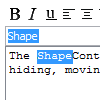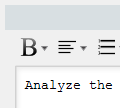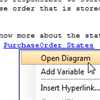 When you copy and paste formatted text into a description editor in Visual Paradigm, it automatically brings along the formatting properties. This sounds reasonable and is quite a nice behavior if you really want to keep the style of text contents. However, there are several reasons why you might not want to keep the formatting. First, when you copy from web page, it may bring along crappy HTML contents, say the hidden table borders and layers. In fact, when CSS is widely used in most of the modern websites, what you copy from a webpage is not necessarily what you can get when pasting without the existence of the CSS. Second, you may not want to mix up the style of text in your description with the source. Third, although the crappy formatting properties may look invisible in the description editor, they may affect the content in generated documentations. After all, to clear those formatting tags is time consuming and error prone.
When you copy and paste formatted text into a description editor in Visual Paradigm, it automatically brings along the formatting properties. This sounds reasonable and is quite a nice behavior if you really want to keep the style of text contents. However, there are several reasons why you might not want to keep the formatting. First, when you copy from web page, it may bring along crappy HTML contents, say the hidden table borders and layers. In fact, when CSS is widely used in most of the modern websites, what you copy from a webpage is not necessarily what you can get when pasting without the existence of the CSS. Second, you may not want to mix up the style of text in your description with the source. Third, although the crappy formatting properties may look invisible in the description editor, they may affect the content in generated documentations. After all, to clear those formatting tags is time consuming and error prone.
Account for the reasons above, it would be nice to have certain ways to paste text without including formatting properties, which means, to paste as plain text. In Visual Paradigm, the “Paste without formatting” function is provided to serve this purpose.
Read more
 The find feature allows you to search for specific words or sentences within text in the description editor. Finding starts from the beginning of the description, regardless of the position of text cursor. The first occurrence of text that matches with the entered search text will be highlighted. You can move to the next occurrence by clicking on the Next button. You can perform finding in all the RTF description editors, such as the description editor in specification window.
The find feature allows you to search for specific words or sentences within text in the description editor. Finding starts from the beginning of the description, regardless of the position of text cursor. The first occurrence of text that matches with the entered search text will be highlighted. You can move to the next occurrence by clicking on the Next button. You can perform finding in all the RTF description editors, such as the description editor in specification window.
 There are two common misunderstanding about use case modeling or
There are two common misunderstanding about use case modeling or  For every model element, there is a description property that allows you to describe detailed information about individual element, so that readers can understand the intended use, intended behavior and other important information. For example, specific implementation guideline can be written in a UML class or
For every model element, there is a description property that allows you to describe detailed information about individual element, so that readers can understand the intended use, intended behavior and other important information. For example, specific implementation guideline can be written in a UML class or  When you copy and paste formatted text into a description editor in
When you copy and paste formatted text into a description editor in  When you are documenting your model, you may come across the situation where you want to make a reference to certain diagram in the project to help you explain an idea or to give reader supplementary information they may find useful. For example, you may want to add into the description of a
When you are documenting your model, you may come across the situation where you want to make a reference to certain diagram in the project to help you explain an idea or to give reader supplementary information they may find useful. For example, you may want to add into the description of a  Sometimes, you may want to give a shape a long name. If the name is so long that it reaches the shape border, it will automatically wrapped. If you dislike the auto wrapping behavior, you can add line breaks to appropriate position yourself. In this article you will learn how to add a line break when editing a shape’s name inline.
Sometimes, you may want to give a shape a long name. If the name is so long that it reaches the shape border, it will automatically wrapped. If you dislike the auto wrapping behavior, you can add line breaks to appropriate position yourself. In this article you will learn how to add a line break when editing a shape’s name inline. Programming languages like C or C++ accepts nameless arguments in function declaration. You may write something like void myFunction(double){…} to declare a function that accepts a double as argument. In modeling level, you can represent this kind of function by not showing the parameter name in an operation. This article shows you how to do this.
Programming languages like C or C++ accepts nameless arguments in function declaration. You may write something like void myFunction(double){…} to declare a function that accepts a double as argument. In modeling level, you can represent this kind of function by not showing the parameter name in an operation. This article shows you how to do this.